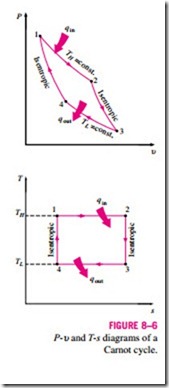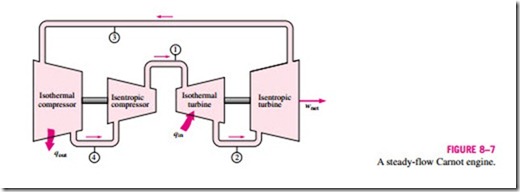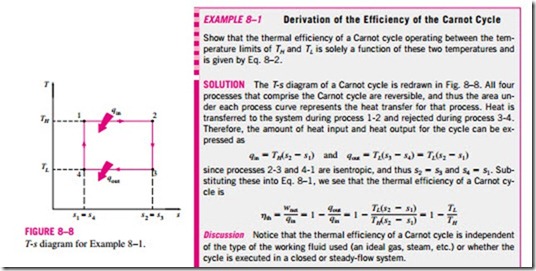■ THE CARNOT CYCLE AND ITS VALUE IN ENGINEERING
The Carnot cycle is composed of four totally reversible processes: isothermal heat addition, isentropic expansion, isothermal heat rejection, and isentropic compression. The P-υ and T–s diagrams of a Carnot cycle are replotted in Fig. 8–6. The Carnot cycle can be executed in a closed system (a piston-cylinder device) or a steady-flow system (utilizing two turbines and two compressors, as shown in Fig. 8–7), and either a gas or a vapor can be utilized as the work- ing fluid. The Carnot cycle is the most efficient cycle that can be executed be- tween a heat source at temperature TH and a sink at temperature TL, and its thermal efficiency is expressed as
Reversible isothermal heat transfer is very difficult to achieve in reality because it would require very large heat exchangers and it would take a very long time (a power cycle in a typical engine is completed in a fraction of a second). Therefore, it is not practical to build an engine that would operate on TH a cycle that closely approximates the Carnot cycle.
The real value of the Carnot cycle comes from its being a standard against which the actual or the ideal cycles can be compared. The thermal efficiency of the Carnot cycle is a function of the sink and source temperatures only, and the thermal efficiency relation for the Carnot cycle (Eq. 8–2) conveys an important message that is equally applicable to both ideal and actual cycles: Thermal efficiency increases with an increase in the average temperature at which heat is supplied to the system or with a decrease in the average temperature at which heat is rejected from the system.
The source and sink temperatures that can be used in practice are not with- out limits, however. The highest temperature in the cycle is limited by the
maximum temperature that the components of the heat engine, such as the piston or the turbine blades, can withstand. The lowest temperature is limited by the temperature of the cooling medium utilized in the cycle such as a lake, a river, or the atmospheric air.


